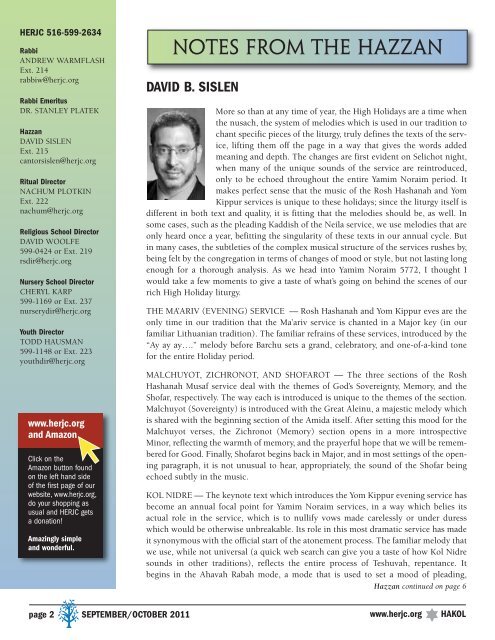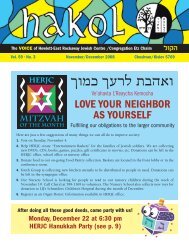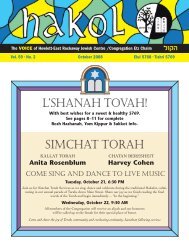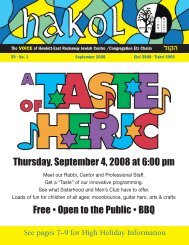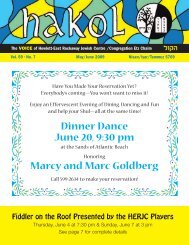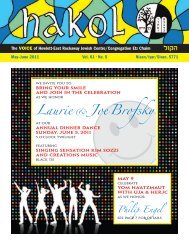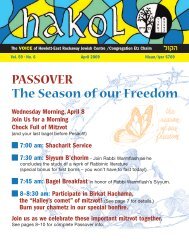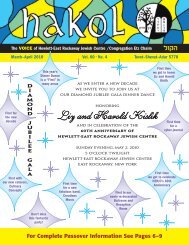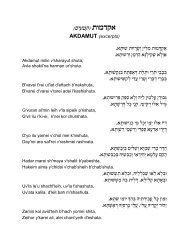It's Happening at HERJC! - Hewlett E. Rockaway Jewish Center
It's Happening at HERJC! - Hewlett E. Rockaway Jewish Center
It's Happening at HERJC! - Hewlett E. Rockaway Jewish Center
You also want an ePaper? Increase the reach of your titles
YUMPU automatically turns print PDFs into web optimized ePapers that Google loves.
<strong>HERJC</strong> 516-599-2634<br />
Rabbi<br />
ANDREW WARMFLASH<br />
Ext. 214<br />
rabbiw@herjc.org<br />
Rabbi Emeritus<br />
DR. STANLEY PLATEK<br />
Hazzan<br />
DAVID SISLEN<br />
Ext. 215<br />
cantorsislen@herjc.org<br />
Ritual Director<br />
NACHUM PLOTKIN<br />
Ext. 222<br />
nachum@herjc.org<br />
Religious School Director<br />
DAVID WOOLFE<br />
599-0424 or Ext. 219<br />
rsdir@herjc.org<br />
Nursery School Director<br />
CHERYL KARP<br />
599-1169 or Ext. 237<br />
nurserydir@herjc.org<br />
Youth Director<br />
TODD HAUSMAN<br />
599-1148 or Ext. 223<br />
youthdir@herjc.org<br />
www.herjc.org<br />
and Amazon<br />
Click on the<br />
Amazon button found<br />
on the left hand side<br />
of the first page of our<br />
website, www.herjc.org,<br />
do your shopping as<br />
usual and <strong>HERJC</strong> gets<br />
a don<strong>at</strong>ion!<br />
Amazingly simple<br />
and wonderful.<br />
notes from the hazzan<br />
DAVID B. SISLEN<br />
More so than <strong>at</strong> any time of year, the High Holidays are a time when<br />
the nusach, the system of melodies which is used in our tradition to<br />
chant specific pieces of the liturgy, truly defines the texts of the service,<br />
lifting them off the page in a way th<strong>at</strong> gives the words added<br />
meaning and depth. The changes are first evident on Selichot night,<br />
when many of the unique sounds of the service are reintroduced,<br />
only to be echoed throughout the entire Yamim Noraim period. It<br />
makes perfect sense th<strong>at</strong> the music of the Rosh Hashanah and Yom<br />
Kippur services is unique to these holidays; since the liturgy itself is<br />
different in both text and quality, it is fitting th<strong>at</strong> the melodies should be, as well. In<br />
some cases, such as the pleading Kaddish of the Neila service, we use melodies th<strong>at</strong> are<br />
only heard once a year, befitting the singularity of these texts in our annual cycle. But<br />
in many cases, the subtleties of the complex musical structure of the services rushes by,<br />
being felt by the congreg<strong>at</strong>ion in terms of changes of mood or style, but not lasting long<br />
enough for a thorough analysis. As we head into Yamim Noraim 5772, I thought I<br />
would take a few moments to give a taste of wh<strong>at</strong>’s going on behind the scenes of our<br />
rich High Holiday liturgy.<br />
THE MA’ARIV (EVENING) SERVICE — Rosh Hashanah and Yom Kippur eves are the<br />
only time in our tradition th<strong>at</strong> the Ma’ariv service is chanted in a Major key (in our<br />
familiar Lithuanian tradition). The familiar refrains of these services, introduced by the<br />
“Ay ay ay….” melody before Barchu sets a grand, celebr<strong>at</strong>ory, and one-of-a-kind tone<br />
for the entire Holiday period.<br />
MALCHUYOT, ZICHRONOT, AND SHOFAROT — The three sections of the Rosh<br />
Hashanah Musaf service deal with the themes of God’s Sovereignty, Memory, and the<br />
Shofar, respectively. The way each is introduced is unique to the themes of the section.<br />
Malchuyot (Sovereignty) is introduced with the Gre<strong>at</strong> Aleinu, a majestic melody which<br />
is shared with the beginning section of the Amida itself. After setting this mood for the<br />
Malchuyot verses, the Zichronot (Memory) section opens in a more introspective<br />
Minor, reflecting the warmth of memory, and the prayerful hope th<strong>at</strong> we will be remembered<br />
for Good. Finally, Shofarot begins back in Major, and in most settings of the opening<br />
paragraph, it is not unusual to hear, appropri<strong>at</strong>ely, the sound of the Shofar being<br />
echoed subtly in the music.<br />
KOL NIDRE — The keynote text which introduces the Yom Kippur evening service has<br />
become an annual focal point for Yamim Noraim services, in a way which belies its<br />
actual role in the service, which is to nullify vows made carelessly or under duress<br />
which would be otherwise unbreakable. Its role in this most dram<strong>at</strong>ic service has made<br />
it synonymous with the official start of the <strong>at</strong>onement process. The familiar melody th<strong>at</strong><br />
we use, while not universal (a quick web search can give you a taste of how Kol Nidre<br />
sounds in other traditions), reflects the entire process of Teshuvah, repentance. It<br />
begins in the Ahavah Rabah mode, a mode th<strong>at</strong> is used to set a mood of pleading,<br />
Hazzan continued on page 6<br />
page 2 SEPTEMBER/OCTOBER 2011<br />
www.herjc.org<br />
HAKOL


